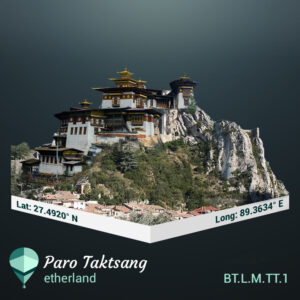 Made of four main temples and residential shelters, the Paro Taktsang monastery sits on the side of a cliff at 3,120 meters high and 900 meters off the ground. The monastery complex was built in 1692 near the cave where Guru Padmasambhava used to meditate and teach Buddhism. He is considered the Second Buddha and an enlightened being that introduced Buddhism in Bhutan.
Made of four main temples and residential shelters, the Paro Taktsang monastery sits on the side of a cliff at 3,120 meters high and 900 meters off the ground. The monastery complex was built in 1692 near the cave where Guru Padmasambhava used to meditate and teach Buddhism. He is considered the Second Buddha and an enlightened being that introduced Buddhism in Bhutan.
Some 900 meters above, 10 km North of the Paro Valley in the Himalayan caves of Bhutan, Paro Taktsang is a Buddhist temple complex that attracts many local and international visitors for its many legends, history, architecture, trekking, and beautiful mountainous views. Despite its dangerous location, as it barely clings to the cliff’s edge, it is considered one of Bhutan’s Holiest and most famous tourist attractions.
Translating as Tiger’s Nest, Paro Taktsang gets its name from one of the thirteen caves nearby which it is located. In this cave, a Buddhist master from India, Guru Rinpoche, meditated and taught Vajrayana (the Buddhist way of living and ideology) to his students in the 8th century. Padma Sambhava, Guru Rinpoche’s other name, was the first to introduce Buddhism in Bhutan. Adding significance to Paro Taktsang both religiously and historically, it made it the cultural icon of Bhutan and such a popular touristic spot.
Like many historical places, Paro Taktsang is also known for its folklore. According to one legend, Guru Rinpoche flew on the back of a tigress from Singye Dzong to the Himalayan mountains and meditated for three years, three months, three weeks, three days, and three hours and later fought the demons that inhabited Paro Valley. A similar folk tale tells that Yeshe Tsogyal, former wife of an emperor, became a disciple of Padma Sambhava and transformed herself into a Tigress. Thus, it is believed that she was the one who carried Guru on her back from Tibet to Bhutan. All of its legends add a lot of mystery to the site. Only a visit can guide visitors in deciding what they should believe.
Amongst the many interests for the folklore, tourists are also visiting to see the body imprints of Padma Sambhav’s body near the cave wall of Kurje Lhakhang temple. They also enjoy the restored chorten, supposed to be the last resting place of Langchen Pelkyi (disciple of Padma Sambhav), who miraculously returned to the monastery after his death in Nepal by the grace of the deity Dorje Legpa.
The temple complex at Paro Taktsang was built in 1692 with four temple buildings and eight caves. Bridges and stone pathways connect the dwellings and the buildings. The modern temple complex was opened in 2005 after the monastery caught fire in 1998, followed by restoration and reconstruction. The white exterior walls and red and golden roofs make the temple look picturesque. The interior is lined with golden ceilings and idols, the famous Hall of a Thousand Buddhas, and a tiger statue. Outside in the courtyard, a large prayer wheel is turned every morning to start the day.
From the Paro Valley, Paro Taktsang looks unreachable because of its unique location. But in reality, three pathways lead to the monastery. The most used trail passes through the pine forest, which is decorated and protected by prayer banners. The other two routes pass through the plateau called A Hundred Thousand Fairies. Almost all three trails have a trekking time of 2-3 hours.
On top of tourists, Paro Taktsang is visited by several religious adherents every year. This temple also grabbed the attention of Prince Charles and Kate Middleton, who visited this place in 2015. Besides this fact, this place remains the cultural icon of Bhutan. Every year, it attracts thousands of visitors that indulge in the local religious traditions and love to contemplate the emerald green mountains.